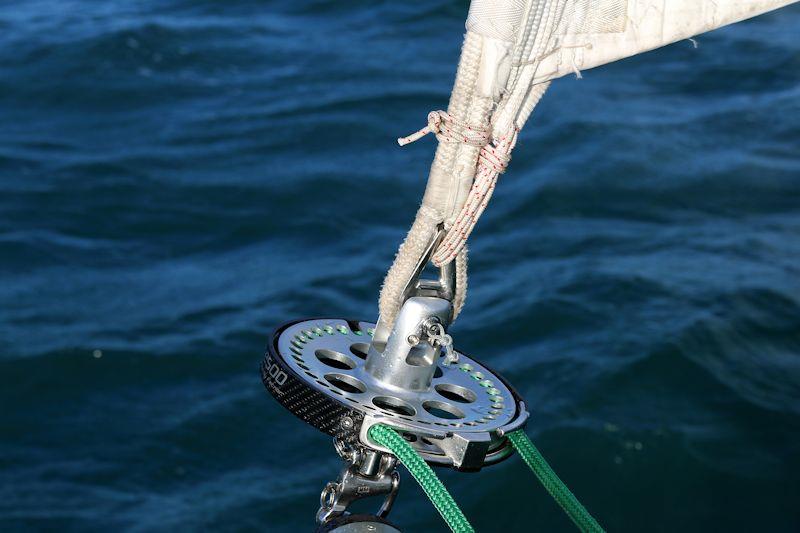
Andy Rice and Bjarne Lorenzen Talk about the Ups and Downs of Top-Down Furling
by Andy Rice 29 Mar 2019 02:00 PDT

upffront.com looks at top-down furling systems © Eric Beauge
In part three of this series, Bjarne Lorenzen of sailmaker Doyle O'leu explains the benefits of top-down furling, one of the big developments of the past decade which has trickled down to the cruising scene from the Volvo Ocean Race.
Traditional 'bottom-up' furling is fine for flat, triangular sails like jibs and even large genoas, but that's as far as it goes. Big, full downwind sails have always needed hoisting and lowering, with all the risk and hassle that goes with that. However, the development of stiff composite torsional cables, over the past 15 years or so, has made 'top-down' furling possible. With the head of a downwind headsail lashed to the top of the cable, when the furler at the base of the cable is turned, the whole cable is sufficiently stiff that it rotates in unison, with only minimal twist. This means a large, powerful headsail can be furled in a matter of seconds, without the need for any crew on the foredeck or the use of a snuffer.
Lorenzen says the pioneering work of the Volvo Ocean Race teams and IMOCA 60 sailors has led to a very useful trickle down of technology for the keen cruising sailor who wants to fly powerful downwind sails in relative comfort and safety. "Top-down furling is great for asymmetric gennakers and code 0 sails," he says. "It makes manoeuvres much easier and less risky and is particularly relevant for short-handed sailing. When you're sailing upwind it is possible to sail around with the cable / sail hoisted. However, I still advise my customers to lower the cable / sail to the deck if they're not going to be unfurling for a while."
Some furling drums have a ratchet inside which avoids any accidental unfurling of the sail, but even then Lorenzen advises lowering the cable when not in use. "Otherwise you're sailing along with a huge 3D shape on a 2D cable. The leech has a huge positive roach, so there's lots of loose cloth around the cable. So best to get it down when not in use, and in any case it's an easy job. If you're not using it for an hour, it's absolutely fine to leave the lowered cable attached to the bow, with the sheets attached, and lash the furled sail to the rail."
For some sailors the top-down furling has replaced the snuffer, while other boats use both systems. "The Black Box snuffer is basically a spinnaker sock made of mesh material, where the funnel is an oval shape. For getting a sail quickly under control, the snuffer is still one of the best options available. When you're thinking about whether to choose one or the other, or maybe both, just weigh up what you're likely to need for your particular circumstances. For a lot of singlehanded sailors, they tend to use the furler for their tight-luffed sails and the snuffer for their looser, free-flying sails. The great thing about the snuffer is you only have to bear away on to a run, pull on the snuffer and you've got the sail under control. But it is harder to hoist and drop than a cable because it blows around more in the breeze."
Lorenzen also points out that there are more setup issues and potential fine-tuning of a top-down furling system.
"A top-down furling system requires a cable with significantly better torsional stiffness than a bottom-up cable. This is because the torsion has to be transferred over the full cable length without any assistance from the sail cloth. This can cause problems when it comes to dropping the sail the sail on the deck. If you have a poor quality torsional cable, it literally winds up like an elastic band and as you release the halyard tension, the cable unwinds itself causing torsional stresses within the furled sail. Therefore, it is very important to use a cable specifically designed for top-down furling, which will minimize this problem."
So while top-down furling is a cleaner way to get the sail up and down, there are some technical things to think about. It's worth investigating top-down furling, but if you're going for absolute simplicity, the snuffer still has a lot to offer."
The above video is one of very few excellent videos explaining top-down furling. If you cannot get your head around top-down furling, watch the full video and you should get a better understanding.
Require more information on furling, or have any questions? Download our free 'Furling Systems' guide, or contact us using our 'Furling Enquiry' page.